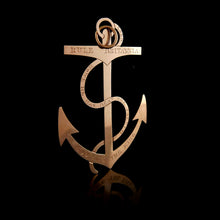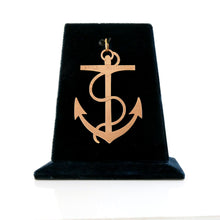Battle of the Glorious First of June Naval Reward Badge, 1794
Adding product to your cart
5.9cm (2.3in) x 4.2cm (1.6in) x 0.5mm (0.019in)
Provenance:
Admiral of the Fleet Sir Richard Howe, 1st and last Earl Howe, K.G. (1726-1799),
Lady Sophia Charlotte, who succeeded her father as second Baroness Howe, thence by descent her to her son,
Richard Curzon-Howe, 1st Earl Howe (1796-1870)
George Curzon-Howe, 2nd Earl Howe (1821-1876)
General Richard Curzon-Howe, 3rd Earl Howe, (1822-1900)
Richard George Penn Curzon, 4th Earl Howe (1861-1929)
Francis Penn Curzon, 5th Earl Howe (1884-1964)
Edward Penn Curzon, 6th Earl Howe (1908-1984), thence by descent
Gold. Anchor pendant engraved 'Rule Britannia’ across the stock, and ‘Lord Howe he has beat the French’ over the foul anchor rope, and ‘God Save The King’ across the arms, commemorating Richard, 1st Earl Howe’s victory over the French Republic’s Atlantic Fleet under Rear Admiral Villaret-Joyeuse on 1 June 1794.
Read more
The present anchor badge appears as illustration no.429, on page 219 of Admiral the Marquess of Milford Haven’s ‘British Naval Medals: Commemorative Medals, Naval Rewards, War Medals’, London, 1919. It belongs to group of three types of anchor reward badge commissioned by Lord Howe K.G. (1726-1799), victor of the Glorious First of June. This and two other anchor pendants, one being of openwork design, remained in the possession of the admiral’s descendants through two centuries. There are three known examples of the openwork model; two of them belonging to Lords Howe and Milford Haven in 1919 (Milford Haven no.430 (illustrated) and no.431 op.cit.) and a third originally in the possession of the victorious admiral’s daughter Louise-Catherine, Marchioness of Sligo (1767-1817). The latter appeared as Lot 134 in Sotheby’s sale The Family Collection of the late Countess Mountbatten of Burma, 24 March 2021.
A popular commander with his sailors, it is generally held that Lord ‘Black Dick’ Howe commissioned anchor badges made from the bronze of captured guns as reward for men who had distinguished themselves in battle (Milford Haven, op. cit., p. 218). The gold versions, according to Milford Haven, were for wear by officers on anniversaries of the battle. It is further suggested that the three examples in gold and gilt with Howe family provenance were made for presentation on the basis of the rank of the recipient.
Known to its contemporaries as the 'Great War', the long conflict between England and Revolutionary France which began in 1793 was characterised by a series of large-scale sea battles in which the Royal Navy proved consistently victorious. After a century of signal victories over successive French fleets, the Royal Navy's senior commanders began the new war with high expectations and the opening fleet action so seized the British public's imagination that the battle henceforward became known as the 'Glorious First of June'. As soon as War had been declared the previous year, the blockading squadrons of the Royal Navy were sent to their stations of the French ports and within months, exacerbated by a poor harvest, serious food shortages were causing civil unrest in cities throughout France, most notably Paris. The United States of America ever mindful of French assistance during its own struggle for independence less than twenty years before, was only too willing to supply France with grain to feed her starving population and it was against this background that the War's first encounter at sea was fought out.
Intelligence had reached the Admiralty that a huge convoy of 117 grain ships was gathering in Chesapeake Bay and the French fleet at Brest was preparing to put to sea in order to escort it safely in. As soon as Admiral Lord Howe received this news, he ordered his own fleet of twenty-six ships-of-the-line to sea and spent much of April and May cruising the Western Approaches in an attempt to prevent the convoy and its escort joining forces. In this respect he was unlucky and, by the time he eventually sighted the enemy on 28 May, both escort and convoy were heading for Brest together. Howe gave chase and a running fight lasting three days ensued during which the French had the advantage of heavy weather. By dawn on 1 June, about 400 miles out in the Atlantic, Howe had managed to get to windward of the French and at 7.16 am signalled his fleet to attack. His strategy was to run his ships down upon the enemy to break their line at its centre and in the ensuing action, HM ships Queen Charlotte, Defence, Marlborough, Royal George and Brunswick did exactly as Howe had intended. By 10 am the two fleets were embroiled in a general mêlée and, by noon, six French ships-of-the-line had been taken and a seventh, Le Vengeur du Peuple, had been sunk after a tremendous duel with HMS Brunswick.
Although escaping capture, the French flagship Montagne was badly mauled and had 300 men killed on her shattered decks. What remained of the French fleet was in great disarray but Howe's ships were also damaged and his crews too exhausted by the encounter to pursue the survivors. Moreover, amidst the confusion of battle, the vital grain convoy sailed on unscathed and managed to reach Brest without loss. In truth therefore, the British victory was tactical rather than decisive but, in the jubilation afterwards, this nicety was overlooked and Lord Howe emerged loaded with honours from a grateful King and country.












